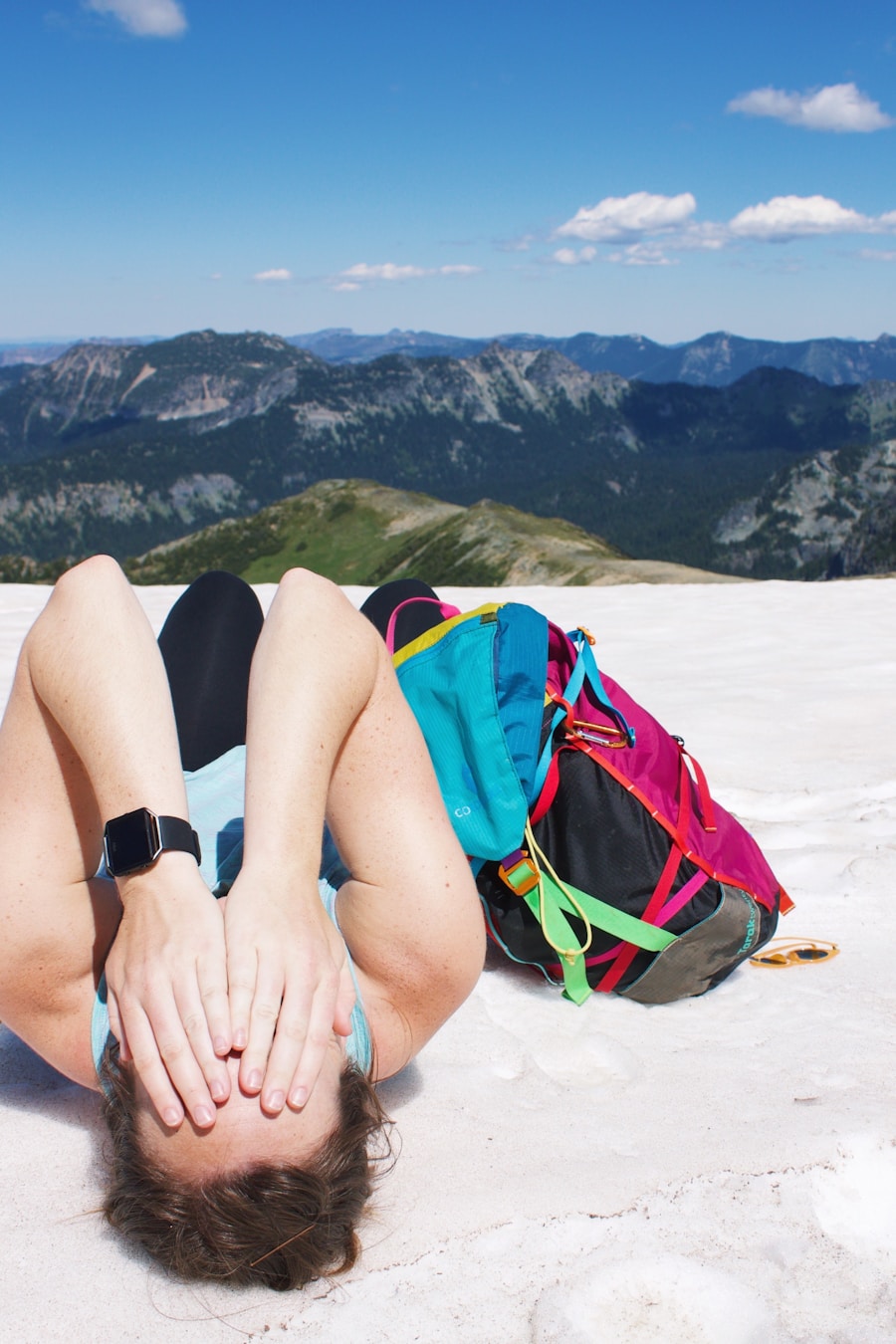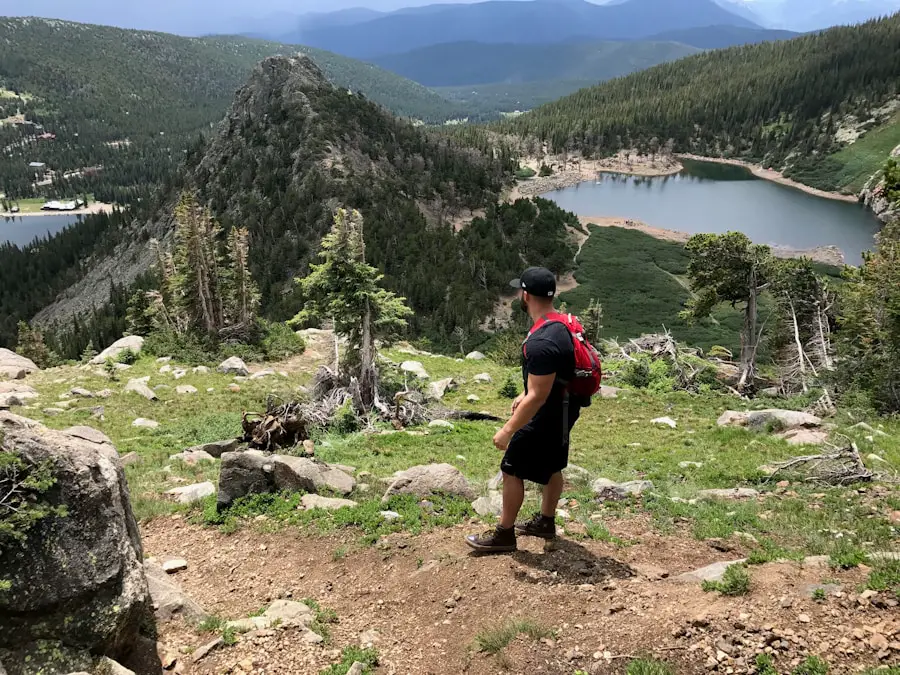The knee is a complex joint that plays a crucial role in mobility and weight-bearing activities. It is primarily composed of three bones: the femur (thigh bone), the tibia (shin bone), and the patella (kneecap). These bones are held together by a network of ligaments, tendons, and cartilage, which provide stability and facilitate movement.
The knee joint is classified as a hinge joint, allowing for flexion and extension, but it also has a slight rotational capability, which is essential for activities such as walking, running, and hiking. The knee’s anatomy includes several key structures that contribute to its function. The medial and lateral menisci are C-shaped cartilaginous discs that act as shock absorbers between the femur and tibia, helping to distribute weight and reduce friction during movement.
Ligaments such as the anterior cruciate ligament (ACL) and posterior cruciate ligament (PCL) provide stability by connecting the femur to the tibia and preventing excessive forward or backward movement. Additionally, the surrounding muscles, particularly the quadriceps and hamstrings, play a vital role in controlling knee motion and absorbing impact during physical activities.
Key Takeaways
- The knee is a complex joint made up of bones, ligaments, tendons, and cartilage, which work together to provide stability and mobility.
- Common causes of knee pain after hiking include overuse, muscle imbalances, improper footwear, and rough terrain.
- Proper footwear and terrain can significantly impact knee health during hiking, with supportive shoes and even surfaces being key factors in preventing pain and injury.
- To prevent knee pain during hiking, it is important to warm up properly, maintain good posture, use trekking poles for support, and take regular breaks to rest and stretch.
- Strengthening exercises such as squats, lunges, and leg lifts can help improve knee stability and reduce the risk of pain and injury during hiking.
Common Causes of Knee Pain After Hiking
Hiking is an exhilarating outdoor activity that can also place significant stress on the knees, leading to pain and discomfort. One of the most common causes of knee pain after hiking is overuse. When individuals hike for extended periods or tackle challenging terrains without adequate preparation, they may experience inflammation in the tendons or bursae surrounding the knee joint.
This condition, known as tendinitis or bursitis, can result in sharp pain and swelling, particularly after long hikes. Another prevalent cause of knee pain is improper technique or body mechanics during hiking. For instance, descending steep trails can place excessive strain on the knees, especially if hikers do not use proper form.
Additionally, carrying heavy backpacks can alter one’s center of gravity, leading to compensatory movements that may strain the knee joint. Furthermore, pre-existing conditions such as osteoarthritis can exacerbate knee pain during or after hiking, as the cartilage that cushions the joint wears down over time, leading to increased friction and discomfort.
Importance of Proper Footwear and Terrain

The choice of footwear is paramount when it comes to preventing knee pain during hiking. Proper hiking boots should provide adequate support, cushioning, and traction to help absorb shock and stabilize the foot. Boots with a firm midsole can help distribute pressure evenly across the foot and reduce the impact on the knees.
Additionally, selecting footwear that fits well is essential; ill-fitting shoes can lead to blisters and misalignment of the foot, which can ultimately affect knee alignment and function. Terrain also plays a significant role in knee health during hiking. Uneven surfaces, steep inclines, and rocky paths can increase the risk of injury and strain on the knees.
Hikers should be mindful of their chosen trails and consider their skill level when selecting routes. For instance, beginners may benefit from starting with flatter, well-maintained trails before progressing to more challenging terrains. Understanding how different surfaces affect knee mechanics can help hikers make informed decisions about their routes and minimize potential pain.
Tips for Preventing Knee Pain During Hiking
| Preventive Tips | Effectiveness |
|---|---|
| Proper warm-up and stretching | Reduces risk of muscle strain and injury |
| Use of trekking poles | Reduces impact on knees by up to 25% |
| Wearing supportive footwear | Provides stability and reduces stress on knees |
| Gradual increase in intensity | Prevents overuse injuries and strain on knees |
| Proper hydration and nutrition | Supports joint health and reduces inflammation |
Preventing knee pain while hiking involves a combination of preparation, technique, and awareness. One effective strategy is to gradually increase hiking intensity and duration. By allowing the body to adapt to longer hikes or more challenging trails over time, individuals can build strength and endurance in their leg muscles, which helps support the knee joint.
Additionally, incorporating rest days into a hiking schedule can prevent overuse injuries by giving muscles and joints time to recover. Another important tip is to practice proper hiking techniques. When ascending or descending hills, hikers should maintain a low center of gravity by bending their knees slightly and using trekking poles for added support.
This technique helps distribute weight more evenly and reduces strain on the knees. Furthermore, being mindful of foot placement on uneven terrain can prevent awkward movements that may lead to injury. Taking shorter strides on steep descents can also help control momentum and reduce impact on the knees.
Strengthening Exercises for Knee Health
Strengthening exercises are essential for maintaining knee health and preventing pain during activities like hiking. Focusing on the muscles surrounding the knee—particularly the quadriceps, hamstrings, calves, and hip muscles—can provide better support for the joint. Exercises such as squats and lunges are particularly effective; they engage multiple muscle groups while mimicking movements used in hiking.
For instance, performing bodyweight squats helps strengthen the quadriceps while promoting proper alignment. Incorporating balance exercises into a fitness routine can also enhance knee stability. Activities such as single-leg stands or using balance boards challenge proprioception—the body’s ability to sense its position in space—thereby improving coordination and reducing the risk of falls or missteps while hiking.
Additionally, resistance training with bands or weights can further enhance muscle strength around the knee joint, providing additional support during strenuous activities.
When to Seek Medical Attention for Knee Pain

While some degree of discomfort may be expected after a long hike, certain symptoms warrant medical attention. If knee pain persists beyond a few days or worsens with time, it may indicate an underlying issue that requires professional evaluation. Swelling around the joint, difficulty bearing weight, or a noticeable decrease in range of motion are all signs that something may be amiss.
In such cases, consulting with a healthcare provider or orthopedic specialist is advisable. Additionally, if hikers experience sharp or sudden pain during an activity—especially if accompanied by a popping sound—it could indicate a ligament tear or other serious injury. Seeking immediate medical attention in these situations is crucial to prevent further damage and ensure appropriate treatment.
Early intervention can often lead to better outcomes and a quicker return to hiking activities.
Benefits of Stretching Before and After Hiking
Stretching plays a vital role in preparing the body for physical activity and aiding recovery afterward. Engaging in dynamic stretching before hiking helps warm up the muscles and increase blood flow to the joints. Movements such as leg swings, walking lunges, or arm circles can enhance flexibility and range of motion while reducing the risk of injury during strenuous activities.
Post-hike stretching is equally important for recovery. Static stretches targeting the quadriceps, hamstrings, calves, and hip flexors can alleviate muscle tightness accumulated during hiking. Holding stretches for 15-30 seconds allows muscles to relax and promotes blood circulation, which aids in recovery by delivering nutrients to fatigued tissues.
Regularly incorporating stretching into a hiking routine can improve overall flexibility and reduce muscle soreness after long treks.
How to Properly Care for Your Knees After Hiking
After a long day on the trails, taking care of your knees is essential for recovery and long-term health. One effective method is to apply ice to any areas of discomfort or swelling for 15-20 minutes at a time. This practice helps reduce inflammation and numbs any pain that may have developed during hiking.
Elevating the legs while resting can also assist in minimizing swelling by promoting better circulation. In addition to ice therapy, gentle movement is beneficial for recovery. Engaging in low-impact activities such as walking or cycling can help maintain mobility without placing excessive strain on the knees.
Hydration is another critical aspect; replenishing fluids lost during hiking supports overall recovery processes within the body. Finally, consider using over-the-counter anti-inflammatory medications if necessary; however, it’s advisable to consult with a healthcare professional before starting any new medication regimen. By understanding knee anatomy, recognizing potential causes of pain, utilizing proper footwear and techniques, engaging in strengthening exercises, knowing when to seek medical help, stretching effectively, and caring for your knees post-hike, individuals can enjoy their outdoor adventures while minimizing discomfort and promoting long-term joint health.
If you are experiencing knee pain after hiking, it may be helpful to consider the impact of your footwear on your joints. According to a recent article on cross-country cat travel tips for a smooth journey, wearing proper hiking shoes with good support and cushioning can help alleviate stress on your knees during long hikes. Additionally, the article provides valuable tips on how to prepare for a hiking trip and ensure a comfortable and enjoyable experience for both you and your feline companion.
FAQs
What are the common causes of knee pain after hiking?
Some common causes of knee pain after hiking include overuse, muscle imbalances, improper footwear, uneven terrain, and pre-existing knee conditions such as arthritis or tendonitis.
How can overuse cause knee pain after hiking?
Overuse of the knee joint during hiking, especially on steep or uneven terrain, can lead to inflammation of the tendons and ligaments surrounding the knee, resulting in pain and discomfort.
How do muscle imbalances contribute to knee pain after hiking?
Muscle imbalances, particularly in the quadriceps, hamstrings, and calves, can put uneven pressure on the knee joint during hiking, leading to pain and potential injury.
Why is proper footwear important in preventing knee pain after hiking?
Proper footwear provides support and stability for the feet and ankles, which in turn helps to reduce the strain on the knees during hiking. Ill-fitting or unsupportive footwear can contribute to knee pain.
What can be done to prevent knee pain after hiking?
To prevent knee pain after hiking, it is important to strengthen the muscles surrounding the knee, wear proper footwear, use hiking poles for added support, and gradually increase hiking intensity to allow the body to adapt.
When should I seek medical attention for knee pain after hiking?
If knee pain persists for more than a few days, is severe, or is accompanied by swelling, redness, or instability in the knee joint, it is important to seek medical attention to rule out any serious underlying issues.
